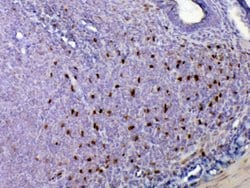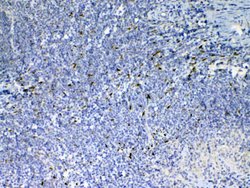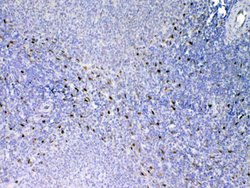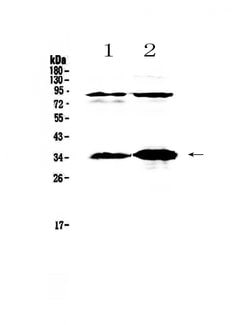Promotional price valid on web orders only. Your contract pricing may differ. Interested in signing up for a dedicated account number?
Learn More
Learn More
Invitrogen™ IL-33 Polyclonal Antibody
Rabbit Polyclonal Antibody
Supplier: Invitrogen™ PA579499
Description
Reconstitute with 0.2 mL of distilled water to yield a concentration of 500 μg/mL. Positive Control - WB: rat spleen tissue, rat lung tissue. IHC: mouse spleen tissue, rat lymphaden tissue, rat spleen tissue.
IL-33 (Interleukin-33) is a 270 amino acid, highly divergent protein belonging to the IL-1 family with an IL-1-like C-terminal domain. IL-33 is a dual function protein that may function both as a proinflammatory cytokine and an intracellular nuclear factor with transcriptional regulatory properties. IL-33 binds to and signals through IL1RL1/ST2 and its stimulation recruits MYD88, IRAK1, IRAK4, and TRAF6. IL-33 activates NF-kappaB and MAP kinases, and drives production of TH2-associated cytokines from in vitro polarized TH2 cells. In vivo, IL-33 induces the expression of IL-4, IL-5, and IL-13 and leads to severe pathological changes in mucosal organs. IL-33 is proteolytically converted to a mature form by CASP1 and is highly expressed in high endothelial venules found in tonsils, Peyer's patches and mesenteric lymph nodes and is almost undetectable in placenta. Prolonged IL-33 treatment of mice led to the development of eosinophilia, splenomegaly, and severe pathological changes in mucosal organs such as lungs, esophagus and small intestine. Recent experiments have shown that IL-33 can also co-localize with heterochromatin and possesses transcriptional repressor activities, indicating that IL-33 may function as both a proinflammatory cytokine and an intracellular nuclear factor with transcriptional regulatory properties. Despite its predicted molecular weight, IL-33 will often run at higher molecular weight in SDS-PAGE. Studies have shown that IL-33 can also co-localize with heterochromatin and possesses transcriptional repressor activities, indicating that IL-33 may function as both a proinflammatory cytokine, and an intracellular nuclear factor with transcriptional regulatory properties.
Specifications
| IL-33 | |
| Polyclonal | |
| Unconjugated | |
| IL1rl1 | |
| 9230117N10Rik; C9orf26; DVS27; DVS27-related protein; H-IL-33; IL1F11; IL-1F11; Il33; IL-33; ILN; Interleukin; interleukin 33; interleukin-1 family member 11; Interleukin33; Interleukin-33; Interleukin-33 (109-270); Interleukin-33 (95-270); Interleukin-33 (99-270); Interleukin-33(102-266); Interleukin-33(109-266); NFEHEV; NFHEV; NF-HEV; nuclear factor for high endothelial venules; nuclear factor from high endothelial venules; RGD1311155; RP11-575C20.2 | |
| Rabbit | |
| Antigen affinity chromatography | |
| RUO | |
| 17082, 25556, 361749, 77125 | |
| -20°C | |
| Lyophilized |
| ELISA, Immunohistochemistry (Paraffin), Western Blot | |
| 500 μg/mL | |
| PBS with 4mg trehalose and 0.05mg sodium azide | |
| P14719, Q62611, Q66H70, Q8BVZ5 | |
| IL1rl1, IL33 | |
| E. coli-derived rat IL33 recombinant protein (Position: A102-M264). | |
| 100 μg | |
| Primary | |
| Mouse, Rat | |
| Antibody | |
| IgG |
Product Content Correction
Your input is important to us. Please complete this form to provide feedback related to the content on this product.
Product Title
Spot an opportunity for improvement?Share a Content Correction



